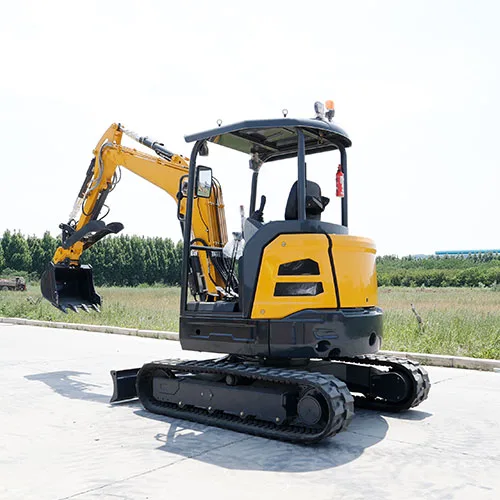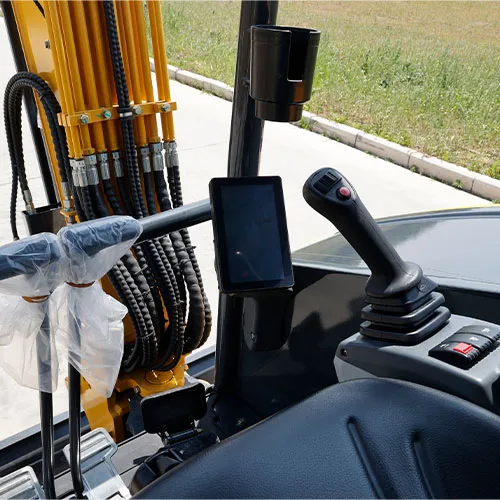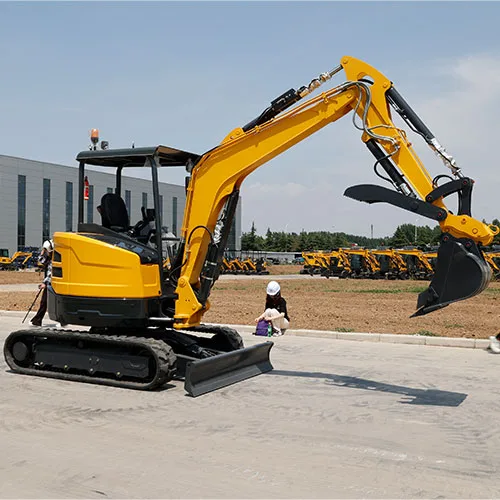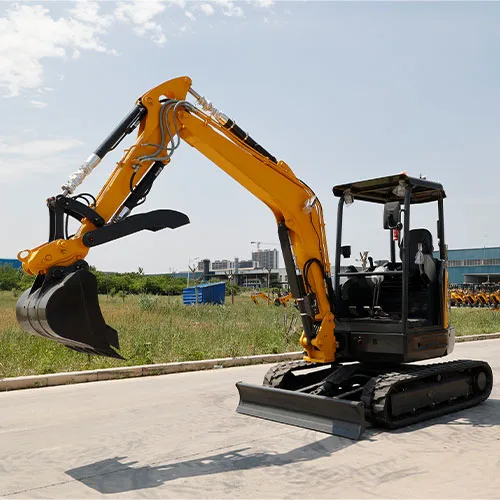Welcome to My Blog!
Before we dive into the content, I’d love for you to join me on my social media platforms where I share more insights, engage with the community, and post updates. Here’s how you can connect with me:
Facebook:https://www.facebook.com/people/Shandong-Huaying-International-Trade-CoLtd/61569380364327/
Now, let’s get started on our journey together. I hope you find the content here insightful, engaging, and valuable.
Table of Contents
Introduction

Small crawler excavators, also known as mini excavators or compact excavators, are versatile construction machines gaining immense popularity in various industries. These compact yet powerful machines are essentially scaled-down versions of their larger counterparts, retaining the core functionality while offering enhanced maneuverability and adaptability. A small crawler excavator is defined by its compact size and the use of continuous tracks (crawlers) for movement, allowing it to navigate challenging terrains and confined spaces with ease. This introduction will delve into the core benefits of using a small crawler excavator, highlighting why they are becoming a preferred choice for numerous projects.
Enhanced Maneuverability and Accessibility of a Small Crawler Excavator
One of the most significant advantages of a small crawler excavator is its exceptional maneuverability. Unlike larger excavators, a small crawler excavator can operate in tight and confined spaces, such as urban construction sites, backyards, and even indoors. Their compact size and zero tail swing (in some models) allow them to rotate within their own footprint, making them ideal for projects with limited operating space. This enhanced accessibility makes a crawler excavator a valuable asset in situations where larger machines simply cannot reach. This benefit is particularly relevant in:
- Urban construction: Navigating narrow streets and congested areas.
- Landscaping: Working in residential gardens and tight spaces between buildings.
- Interior demolition: Operating within existing structures.
Versatility and Adaptability of a Small Crawler Excavator
A small crawler excavator is a remarkably versatile machine capable of performing a wide range of tasks. Thanks to a variety of attachments, a crawler excavator can be easily configured for different applications. Common attachments include:
- Buckets: For digging, trenching, and material handling.
- Augers: For drilling holes for posts, foundations, and other applications.
- Breakers: For demolition and breaking up concrete or rock.
- Grapples: For handling logs, debris, and other materials.
This adaptability makes a crawler excavator a cost-effective solution, eliminating the need for multiple specialized machines. A single crawler excavator can be utilized for digging trenches one day and breaking concrete the next, maximizing its utilization and return on investment.
Cost-Effectiveness of a Small Excavator


Choosing a crawler excavator often translates to significant cost savings. Compared to larger excavators, a crawler excavator typically has a lower purchase price, reduced operating costs, and lower transportation expenses.
- Lower fuel consumption: Smaller engines consume less fuel, leading to lower operating costs.
- Reduced maintenance: Smaller machines generally require less maintenance and fewer replacement parts.
- Easier transportation: A small crawler excavator can be transported on smaller trailers, reducing transportation costs.
These cost advantages make a small crawler excavator a financially viable option for smaller businesses and individual contractors.
Reduced Environmental Impact of a Small Crawler Excavator
In today’s environmentally conscious world, reducing the environmental impact of construction activities is crucial. A small excavator offers several environmental benefits compared to larger machines.
- Lower emissions: Smaller engines produce fewer emissions, contributing to cleaner air.
- Reduced ground disturbance: The lighter weight and rubber tracks of a small excavator minimize ground damage, particularly on sensitive surfaces like lawns and landscaping.
- Lower noise pollution: Smaller engines typically generate less noise, reducing disturbance to surrounding areas.
These environmental advantages make a crawler excavator a more sustainable choice for various projects.
Safety Features of a Small Crawler Excavator
Modern crawler excavators are equipped with numerous safety features to protect operators and bystanders. These features include:
- Roll-over protective structures (ROPS): To protect the operator in case of a rollover.
- Falling object protective structures (FOPS): To protect the operator from falling debris.
- Operator presence systems: To prevent the machine from operating unless the operator is in the seat.
- Backup cameras and alarms: To improve visibility and prevent collisions.
These safety features contribute to a safer working environment and reduce the risk of accidents.
Table: Key Features and Applications of a Small Crawler Excavator
The following table summarizes the key features and typical applications of a small crawler excavator:
| Feature | Description | Typical Applications |
|---|---|---|
| Size | Compact and maneuverable, suitable for confined spaces. | Landscaping, residential construction, utility work, interior demolition, agriculture. |
| Tracks (Crawlers) | Provides excellent traction and stability on various terrains, including soft and uneven ground. | Construction sites, farms, forests, and other off-road environments. |
| Attachments | Wide range of attachments available, including buckets, augers, breakers, grapples, and more, enabling versatility for different tasks. | Digging, trenching, demolition, material handling, drilling, and more. |
| Operating Weight | Typically ranges from 1 to 10 tons. | Varies depending on the model and configuration. |
| Digging Depth | Varies depending on the model, typically ranging from 6 to 15 feet. | Varies depending on the model and boom configuration. |
| Engine Power | Typically ranges from 10 to 70 horsepower. | Sufficient power for various tasks while maintaining fuel efficiency. |
| Transportation | Can be easily transported on smaller trailers, reducing transportation costs. | Convenient for moving between job sites. |
Maximizing the Efficiency of Your Small Crawler Excavator
To maximize the efficiency and lifespan of your small crawler excavator, consider the following tips:
- Regular maintenance: Follow the manufacturer’s recommended maintenance schedule.
- Proper operator training: Ensure operators are properly trained on the safe and efficient operation of the machine.
- Correct attachment selection: Choose the appropriate attachment for each task.
- Careful operation: Avoid overloading the machine and operating on excessively steep slopes.
By following these guidelines, you can ensure that your crawler excavator performs optimally and provides years of reliable service.
Choosing the Right Small Crawler Excavator
Selecting the right small crawler excavator depends on the specific needs of your project. Consider the following factors:
- Project size and scope: Determine the size and type of tasks you will be performing.
- Operating environment: Consider the terrain, space constraints, and other environmental factors.
- Budget: Determine your budget and compare different models within your price range.
- Dealer support: Choose a reputable dealer who offers good after-sales service and support.
By carefully considering these factors, you can choose a small excavator that meets your specific requirements and provides the best value for your investment.
The Future of Small Crawler Excavators

The future of crawler excavators looks promising, with ongoing advancements in technology and design. These advancements include:
- Improved fuel efficiency: New engine technologies are reducing fuel consumption and emissions.
- Enhanced operator comfort: Improved cab designs and ergonomics are enhancing operator comfort and productivity.
- Increased automation: Advanced control systems and automation features are improving precision and efficiency.
- Electric and hybrid models: The development of electric and hybrid crawler excavators is contributing to a more sustainable construction industry.
These advancements will further enhance the versatility, efficiency, and environmental friendliness of small crawler excavators.
Conclusion
In conclusion, a small crawler excavator offers a wide range of benefits for various construction, landscaping, and other projects. Their enhanced maneuverability, versatility, cost-effectiveness, and reduced environmental impact make them a valuable asset in many industries. By carefully considering your project needs and selecting the right machine, you can maximize the benefits of using a small crawler excavator and achieve your project goals efficiently and effectively. The future of small crawler excavators is bright, with ongoing advancements promising even greater performance and sustainability.
FAQ
Q: What is the difference between a small crawler excavator and a backhoe loader?
A: A small crawler excavator is primarily designed for digging and excavating, while a backhoe loader is a more versatile machine that combines a loader bucket on the front and a backhoe on the rear. A small crawler excavator generally offers better digging performance and maneuverability in confined spaces.
Q: What size trailer is needed to transport a small excavator?
A: The size of the trailer depends on the weight and dimensions of the small excavator. Typically, a trailer with a capacity of 10,000 to 20,000 pounds is sufficient for most small excavators.
Q: What type of maintenance is required for a small crawler excavator?
A: Regular maintenance includes checking and changing fluids (engine oil, hydraulic fluid, coolant), inspecting and lubricating tracks and undercarriage components, checking filters, and inspecting hoses and connections. Consult the manufacturer’s manual for specific maintenance recommendations.




